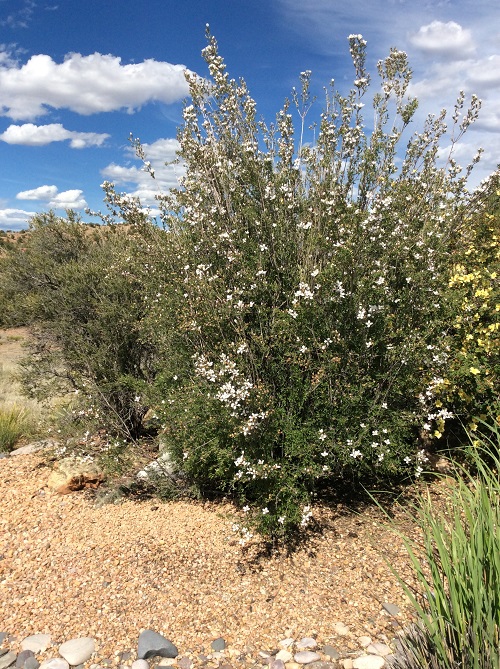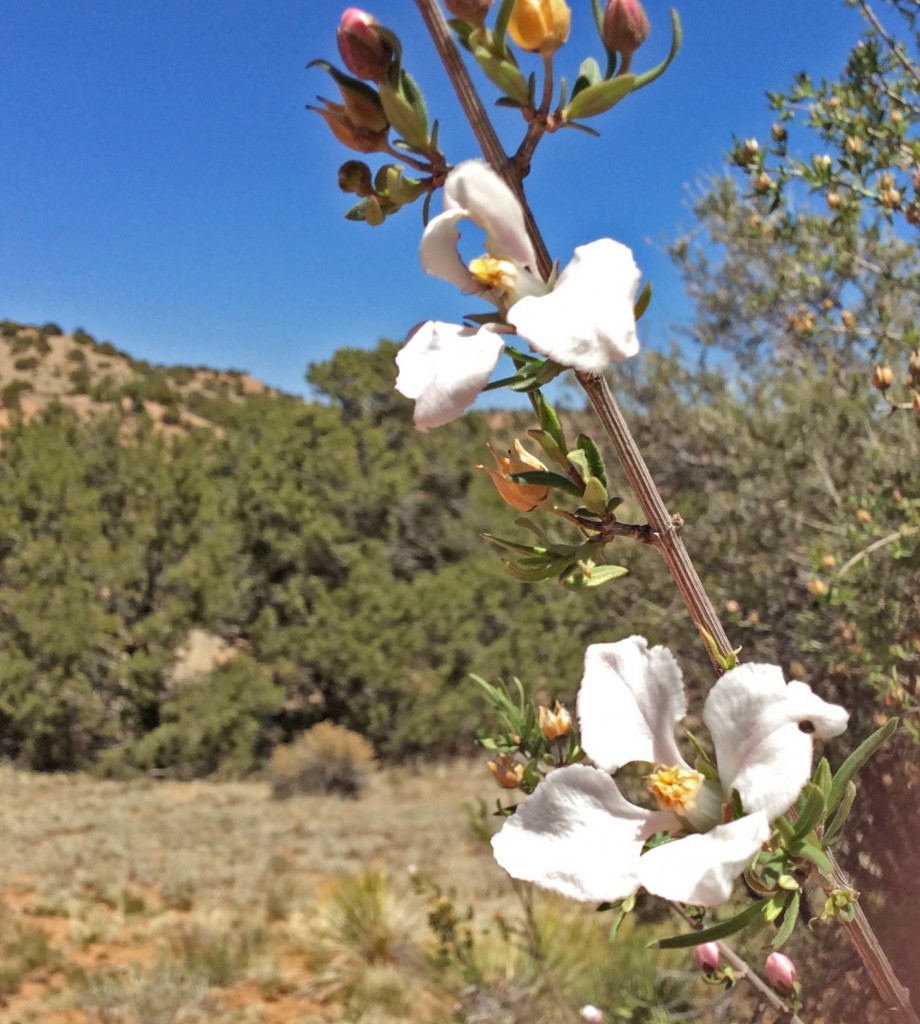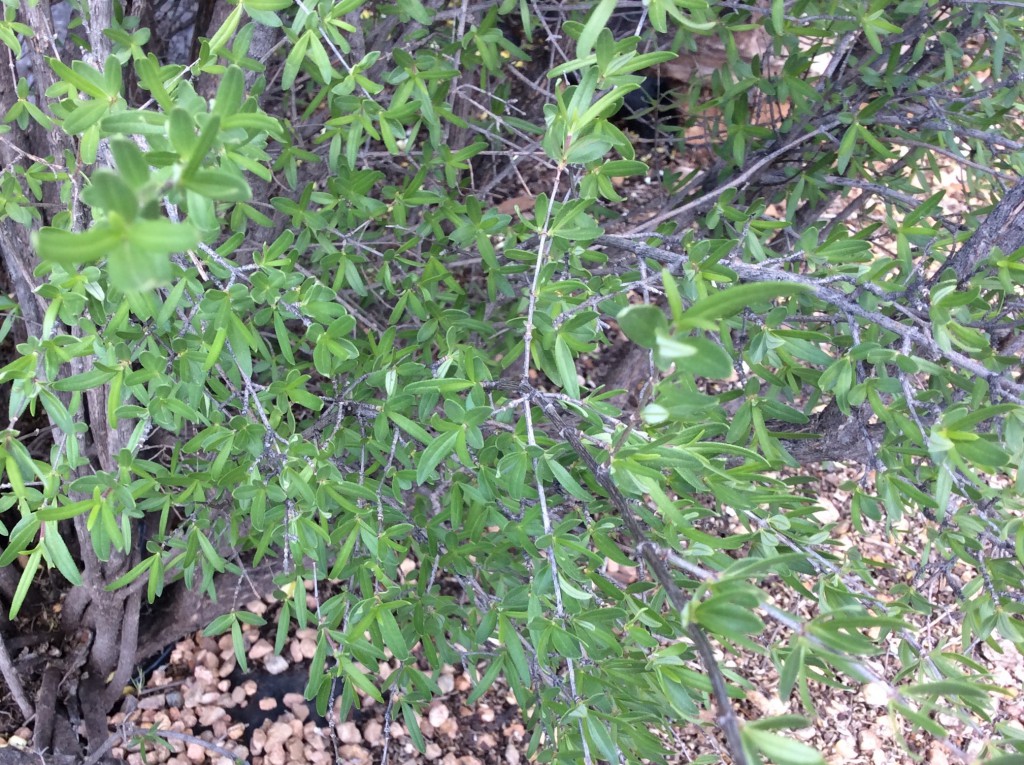Scientific name: Fendlera rupicola

Fendera rupicola (photo by Jeanne Gozigian)
Synonym: Fendlera rupicola var. falcate
Common names: cliff fendlerbush, false mock-orange
Plant family: Hydrangeaceae
Article and photos by Jeanne Gozigian
One of my early hiking/climbing adventures after moving to New Mexico in 1989, was a trek to a little known window rock, over hill, dale and cliff. It was a hot, sunny day, probably in May or June, dusty, and dry as a bone. On an arid, steep, rocky hillside was an improbable sight – a large bush covered with a profusion of white, pink-tinged flowers, growing in red-brown soil that looked like it had not seen moisture in eons.
At first, I thought it was a member of the rose family, but there were only four petals in the blossoms and they were oddly shaped.
The broad, rounded (sometimes ragged) tips tapered to very narrow bases (known as claws in botanical speak), and had distinctive whitish stamens. I could not wait to get to my wildflower and shrub resources and quickly identified it as Fendlera rupicola. I found it at a nursery when we built a new house with new landscaping several years later and it has been living and growing happily ever after, with no supplementary watering. The tiny youngster I purchased from Plants of the Southwest, a Santa Fe nursery, now tops 8 feet.

Fendlera rupicola flower (photo by Jeanne Gozigian)
Cliff fendlerbush is a semi-evergreen perennial shrub with multiple branches. The narrow green leaves have rolled margins. The new bark is reddish-tan which becomes shredded gray with age. It grows in the south central montane regions of North America in the states of Arizona, Colorado, New Mexico, Nevada, Texas, and Utah and in northern Mexico. It may flower in March, April, May, or June, depending on the location. The bright pink buds turn a brilliant white when the blossom matures. It is a good fit for our area gardens because it takes full sun, low water use, and loves dry soil – igneous or limestone. It can get lanky and is improved by pruning. The fruit capsules tend to stay on the shrub for long periods of time. Flowers of plants in the Hydrangea family tend to have rounded or flattened clusters/heads.
The columnar, vase-shape of the shrub lends itself to tall narrow spaces. The thick, 1 ½ “, lanceolate –shaped, opposite paired leaves are hairless and have 3 lengthwise veins. The shrubs are hardy to 8,000 feet in elevation. George Englemann and Asa Gray named the species from a collection near New Braunfels, Texas, in 1850. William Weber maintained that only the Texas plants are true rupicola; all other states’ populations are var. falcata. Other botanists have disagreed, which is why var. falcate is a synonym. Rupicola means “rock dweller” in Latin and falcata means sickle-shaped. Plants with “Fendler “ in their binomial names are in honor of

Leaves of Fendlera rupicola (Photo by Jeanne Gozigian)
Augustus Fendler (1813-1883), a German collector of plants in the Hydrangeaceae family from North and Central America. Another collector, the Colonial American John Bartram, who famously collected seeds and plants from America to send to English gardeners, gathered Hydrangea arborescens seeds in Pennsylvania in 1736. The first specimens flowered in 1746 and were widespread in England by 1775. This is a well-loved, well-traveled, plant family. The family name, Hydrangea, is derived from the Greek; hydor is water and angos, a cup, because the fruit is cup-shaped.
Fendlera rupicola, pronounced FEND-ler-uh roo pee-koh-la, typically lives in a desert and mesa habitat with one-seed juniper, pinon, three-leaf sumac and mountain mahogany. As with most native plants, the early Native Americans found traditional uses for it. Some tribes used it in their ceremonies. Others got really creative, using it as a treatment for head lice, as a cathartic, and to make forks, planting sticks and knitting needles. Here is a recipe for a kind of mush: Boil juniper berries, rupicola buds and pinon buds with cornmeal! Don’t try this at home, as some species of juniper berries may be toxic.
At the Botanical Garden at Museum Hill, Fendlera rupicola is located at the newly opened Ojos y Manos, in the Sunrise Discovery Garden.
Thanks to Helen Woody and Janice Tucker for proofreading this article.
Sources:
The American Southwest, www.americansouthwest.net
The Brother Gardeners; Botany, Empire , & the Birth of an Obsession, Andrea Wulf, Alfred A. Knopf, New York, 2008
Colorado Springs Utilities Xeriscaping, www.waterwiseplants.org
Lady Bird Johnson Wildflower Center
Low Water-use Landscape Plants for the Southwest, aces.nmsu.edu
Southwest Colorado Wildflowers, www.southwestcoloradowildflowers.com
Stearn’s Dictionary of Plant Names for Gardeners, William T. Stearn,
Cassell Publishers Limited, London UK, 1992
Texas Native Plants Database


